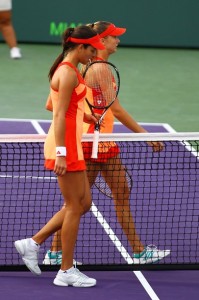By Thomas Swick
At quarter past 10 on Sunday morning two Miami-Dade police officers in brown uniforms walked around thequiet grounds.
“There are great matches on all these courts,” the lead officer said, walking between the stands of 1 and 6. He then told his colleague of the crush for autographs afterwards. At that hour of the morning, it was a bit hard to imagine.
“I didn’t realize there was such a following for tennis,” the other officer said.
“Oh yeah,” the first one said. “It’s incredible to see grown men telling their children and grandchildren to go up and touch a player, touch his sweat.”
At the bottom of the stairs leading to the media center a photographer aimed his zoom at a car disgorging tall women with racket bags.
“Who we got?” I asked.
“I have no idea,” the man said laughing. “They all look like Sharapova.”
Tennis: the sport of clones.
There were only a handful of people in the stadium when Tomas Berdych, the tall blond Czech, and Grigor Dimitrov, the shorter, darker Bulgarian, walked onto the court for the day’s first match. Despite being different physical types, they still managed to look like clones by the simple fact that they had put on identical outfits for the day. Both wore the same turquoise shirt with one white and one blue stripe on each shoulder, white shorts, and white sneakers with identical turquoise laces and a turquoise swoosh on the side. The only difference was that Berdych wore a cap and one extra wristband.
Despite the small crowd, it was a different atmosphere for Dimitrov than at his previous match, for now he was warming up while music played and his picture appeared on the big screen. Though he’s not unaccustomed to the big time: Serena was in the stands, lending her support.
Dimitrov was as much fun to watch as he was against Chela, doing a split, a la Clijsters, on one point and falling down on another, behind the baseline, but still managing to get the ball back by sticking his racket up in self-defense while sitting down. He lost the point but won the match, his first victory over a top 10 player. In the upper deck, a small group unfurled a Bulgarian flag.
Out in the grounds, an older Swiss man was lecturing a younger Peruvian woman on overdevelopment while watching on the screen the Venus Williams-Aleksandra Wozniak match.
“What’s going to happen to the Everglades? What’s going to happen to our water? The next war will be fought not over oil but over water.”
I went and bought a lemonade.
Gael Monfils was hitting on a practice court, skying for lobs like Jordan going for a slam. Once he walked up to a ball sitting near the service line and with one fell swing, like a golfer, hit it over the net. It’s only on the practice courts that you see the parlor tricks players can perform with their rackets.

Back in the stadium, the Williams-Wozniak match had turned into a museum piece of unforced errors. Serving for the match in the third set, Wozniak produced two blatant, hapless double faults. Groans and hisses rained down from the stands. There are two types of people in the world: those who sympathize and those who critique, and it seemed that for every spectator who knew the feeling there was one who wanted better for his money.
Since neither woman could hold serve, the set went to a tiebreak. Venus won her first mini-break on a net ball, pumping her fist instead of falsely apologizing. When she won the final point, Wozniak’s father and coach, having just suffered through an excruciating thirty minutes, rose from his seat and applauded.
Six reporters showed up for Wozniak’s press conference. She sat in a small folding chair with her legs crossed and her mind positive. She laughed frequently, and I wondered if it was to ward off tears. I asked her what her father had said to her after the match, and she said he had told her “good match, we’re back on track” and that “there are some things we need to work on.” I asked if this was her first time playing in the stadium, and she said it was, and that it was “beautiful.”
For the next match in the stadium, Daniela Hantuchova and Ana Ivanovic walked onto the court in identical orange dresses and identical orange visors. What is it with dressing for the big stage? Don’t these clothing lines have enough appealing designs to go around? I tried to imagine the women’s reactions when they first spotted each other in the walkway. Though the distinctive purple court surrounded by a sea of green and now bookended by moving patches of orange looked rather striking. It made me think of Bud Collins.
